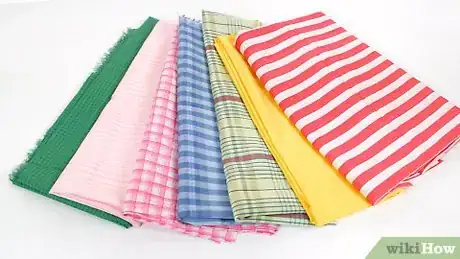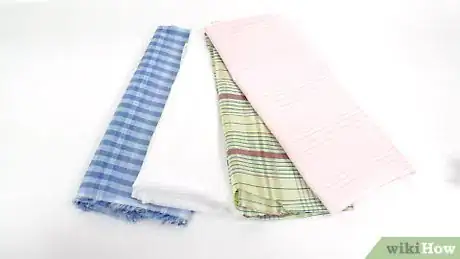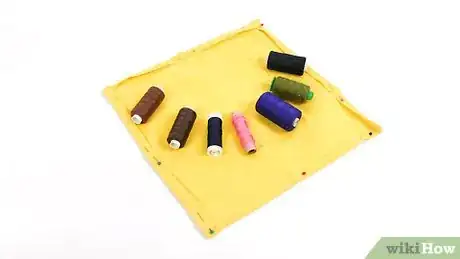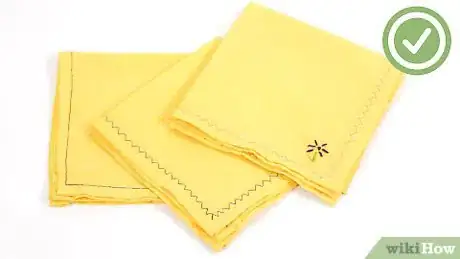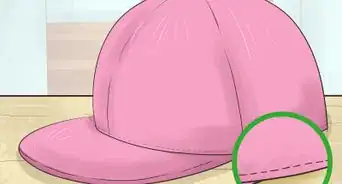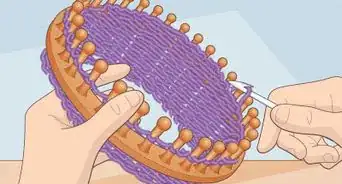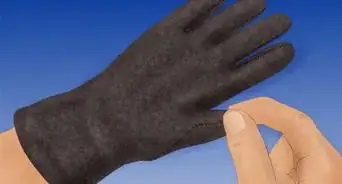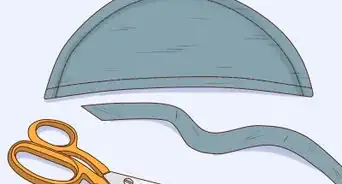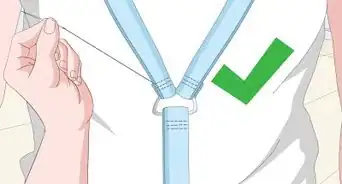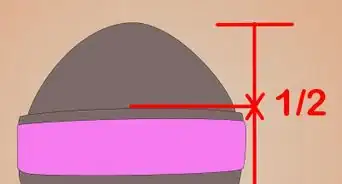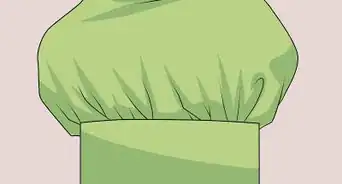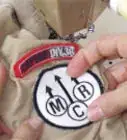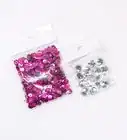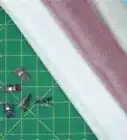This article was co-authored by Seleh Rahman. Seleh Rahman is a Tailor, Furrier, and the Owner of Seleh de Federal Hill in Baltimore, Maryland. With over 45 years of experience, Seleh specializes in fur, alterations, and fashion illustration. Seleh studied Fashion Design and Tailoring at Bay College of Maryland. He holds certifications in fur, design, and tailoring.
wikiHow marks an article as reader-approved once it receives enough positive feedback. In this case, 100% of readers who voted found the article helpful, earning it our reader-approved status.
This article has been viewed 417,247 times.
Handkerchiefs are functional, classic accessories. You can carry a handkerchief with you in your purse or wear a folded handkerchief tucked into the pocket of a jacket or blazer. Choose your fabric, cut it to the desired dimensions, fold and press the edges, and then sew the edges in place. Make handkerchiefs to use and pair with your wardrobe, or to give as useful gifts!
Steps
Choosing Fabric for a Handkerchief
-
1Choose cotton for a functional handkerchief. If you want a handkerchief that you can use to blow your nose and wipe your face, cotton is the way to go. You can choose from many different types of print or solid cotton fabric to create your handkerchief. Cotton is also the most inexpensive option.[1]
- Try choosing cotton fabric in seasonal or holiday prints to make festive handkerchiefs to use throughout the year, such as 4 leaf clover fabric for St. Patrick’s day, leaf print fabric for fall, or red and green fabric for Christmas.
- Pick cotton fabrics that will coordinate with your clothing, such as pink fabric to match a pink dress, or yellow fabric to complement a purple suit.
-
2Opt for a specialty fabric for a delicate design. Decorative handkerchiefs are often made from lightweight and/or delicate fabrics. If you want to create a handkerchief that will look good as an accessory or as a decorative piece, then look into lightweight and sheer fabrics, such as:[2]
- Silk
- Chiffon
- Light muslin
- Satin
Advertisement -
3Try a heavy fabric for a durable handkerchief. If you want your handkerchief to be strong and durable, opt for a heavy fabric, such as flannel or linen. Make sure that the fabric is something that you can wash and that will not pill or shrink.
- Wool, tweed, flannel, and cashmere are traditional fabrics for winter pocket squares.[3]
- You could even use an old pair of flannel pajamas or an old linen tablecloth as your fabric. Cut it into squares and use them to make your handkerchiefs.
Folding and Pressing the Fabric
-
1Iron the fabric before you start folding if desired. If the fabric is wrinkled or has bumps in it, then you might want to iron it first. This will help to ensure that your final result will be neat. Spread the fabric out on a flat surface, such as an ironing board or on top of a clean, dry towel on a table or counter. Run the warm iron back and forth over the fabric several times to flatten it out.[4]
- Place a T-shirt or towel over the fabric if you are concerned about damaging it. This is especially important for delicate fabrics, such as silk, chiffon, and lace.
- Set your iron to the lowest possible setting for the fabric you are using. This will also help to prevent damage to the fabric.
-
2Cut the fabric into a 11.5 by 11.5 in (29 by 29 cm) square. This will allow you to make a handkerchief that measures 10.5 by 10.5 in (27 by 27 cm). You can cut the handkerchief to larger or smaller dimensions if desired. You will need to cut the square 1 in (2.5 cm) larger than the desired dimensions. Some common handkerchief sizes include:[5]
- 12 by 12 in (30 by 30 cm) is the standard size for a pocket square. If you are making a handkerchief to wear in the pocket of a suit, then cut your fabric to 13 by 13 in (33 by 33 cm).[6]
- If you want the folded edges to be wider or narrower or if you want to fold the fabric more than 1 time, then make sure to account for this with extra fabric. For example, if you want to make 2 0.5 in (1.3 cm) folds on each edge of the handkerchief, then add a total of 2 in (5.1 cm) of fabric to each side.
-
3Fold the edge over on 1 side by 0.5 in (1.3 cm). Place the fabric so that the wrong (back) side of the fabric is facing up. Measure from the raw edge on 1 side of the handkerchief and fold the fabric over by 0.5 in (1.3 cm).
- If you want a smaller or wider folded edge, then fold the fabric to the desired width. For example, if you want 0.75 in (1.9 cm) folds on each edge of the handkerchief, then fold over the fabric by 0.75 in (1.9 cm) on all 4 sides.
-
4Pin the folded edge if desired. If you are not concerned about poking holes into the fabric, then insert pins into the folded edges of your fabric to secure it. Place the pins perpendicular to the fold to make it easier to remove them as you sew. Place 1 pin about every 2 to 3 in (5.1 to 7.6 cm) along the folded edge.
- Avoid using pins with delicate fabrics, such as silk, chiffon, and satin.
-
5Press the folded edge with an iron to crease it. Iron over the edge of the handkerchief that you just folded. If you are using a delicate fabric, then you may want to place a T-shirt over the edge of the napkin and iron over the edge using the lowest setting.
- Keep in mind that this is optional, but it will result in much neater edges on your handkerchiefs.
-
6Repeat the process on the other edges. After you have finished folding and pressing 1 edge of the handkerchief, do the same for the next edge. Repeat until you have folded and pressed all 4 edges of the handkerchief.
Sewing the Handkerchief
-
1Choose thread that matches or complements your fabric. The thread you choose will depend on the color of your handkerchief fabric and how much you want the stitching to stand out. If you want the thread to blend in with the fabric, then choose a thread color that matches the color of the fabric. If you want the thread to stand out, choose something that will complement or contrast with the fabric.
- For example, if you are making light blue handkerchiefs and want the thread to blend in then the opt for a light blue thread.
- If you are making red print napkins and want the thread to contrast with your fabric, then opt for white or black thread.
-
2Secure the folded fabric with a straight stitch for a simple design. Set your sewing machine to the straight stitch setting and sew 0.25 in (0.64 cm) from the folded edges on all 4 sides. This will secure the folded fabric in a simple way, so it is ideal if you just want a functional handkerchief or if you don’t want the stitching to stand out on a printed fabric.[7]
- For example, if you are making simple cotton handkerchiefs, then you might opt for a straight stitch to keep the design simple and clean.
-
3Opt for zigzag stitch for something decorative. The zigzag stitch will stand out more than a straight stitch, even if the thread is the same color as your fabric. Choose this stitch if you want to create eye-catching stitching along the edges of your handkerchiefs. You can sew along the edges of the folded fabric or sew over it with the zigzag stitch. Sew along all 4 sides of the handkerchief to secure the hem.[8]
- For example, if you are making yellow handkerchiefs with blue thread and want the stitching to stand out, the zigzag stitch would be a great option.
-
4Sew the hem by hand for a delicate fabric. Insert the end of your thread through the eye of a needle and then pull through until you have 18 in (46 cm) of thread on 1 side of the eye of the needle and 3 in (7.6 cm) on the other side. Tie a knot in the long end of the thread and begin sewing along the raw edge of the folded fabric. Insert the needle through the fabric about 0.25 in (0.64 cm) from the raw edge and bring it all the way through both layers of the folded fabric until the thread it taut. Then, bring the needle back through on the other side of the fabric about 0.25 in (0.64 cm) from the first stitch.
- If you want to ensure that the stitches won’t be visible at all, then you may want to sew it by hand.
- This is also a great option for delicate fabrics, which are more likely to get damaged by a sewing machine.
-
5Embroider your handkerchief to add another decorative element. If you would like, you can embroider the finished handkerchief with initials or another design. If you have a sewing machine with an embroidery setting, then you can use it to embroider a design onto the handkerchief. Or, you can also hand embroider your handkerchief.
- Try embroidering initials onto the corner or center of the handkerchief for a personal touch.
- Add an embroidered flower to a corner or the center of the handkerchief for a pretty touch.
- Include an embroidered edge for a decorative finish.
Community Q&A
-
QuestionHow much material do I need to make a handkerchief?
 Community AnswerTypically, a man's handkerchief is 12x12 inches (about 30cm) square. A woman's is 8x8 (22cm) square.
Community AnswerTypically, a man's handkerchief is 12x12 inches (about 30cm) square. A woman's is 8x8 (22cm) square. -
QuestionHow would I put lace on the handkerchief?
 Patt KauffmanCommunity AnswerLace can be sewn on the unfinished handkerchief, right sides together, allowing a bit of extra to accommodate the corners. Gathered lace works best; if you have a flat piece of lace, you can gather it first by sewing a running stitch either by hand or with a sewing machine.
Patt KauffmanCommunity AnswerLace can be sewn on the unfinished handkerchief, right sides together, allowing a bit of extra to accommodate the corners. Gathered lace works best; if you have a flat piece of lace, you can gather it first by sewing a running stitch either by hand or with a sewing machine. -
QuestionSince I don't have a sewing machine, can I make a handkerchief without sewing? I don't want to sew by hand.
 Courtney SikoraCommunity AnswerIron on fabric tape also works. Make sure it can go through the wash. Do not use temporary hemming tape.
Courtney SikoraCommunity AnswerIron on fabric tape also works. Make sure it can go through the wash. Do not use temporary hemming tape.
References
- ↑ https://sewguide.com/embroidered-handkerchief-diy/
- ↑ https://sewguide.com/embroidered-handkerchief-diy/
- ↑ https://www.businessinsider.com/how-to-wear-pocket-squares-2015-7
- ↑ https://sewing.com/diy-handkerchief/
- ↑ https://sewing.com/diy-handkerchief/
- ↑ https://www.businessinsider.com/how-to-wear-pocket-squares-2015-7
- ↑ https://sewing.com/diy-handkerchief/
- ↑ https://sewguide.com/embroidered-handkerchief-diy/
About This Article
To make your own handkerchief, wash and dry a piece of fabric to make sure it won’t shrink after you finish sewing. Then, cut the fabric into an 11.5 by 11.5 inch square, and fold each edge of the square over 1/2 inch for the seam. Press the creases with an iron, and choose a thread color that coordinates with your handkerchief fabric. Stitch the edge all the way around with a sewing machine, then iron and fold your new handkerchief. To learn more about choosing a stitch for your handkerchief, keep reading!
